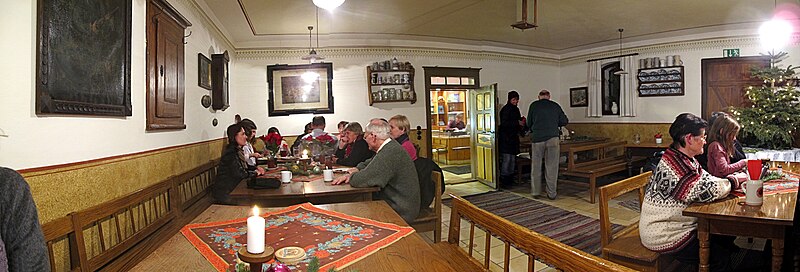Room
Stube etymologically refers to a heated living room (the word comes from Ahd. Stuba , is related to English stove , stove, and is derived from extufare , “to evaporate”, in popular Latin ). In the past, the parlor was often the most important room in an apartment or house and was originally characterized by smoke-free heating using hot air heating or a rear- loading stove ( tiled stove ). In winter in particular, the parlor was often the only heatable room and thus the main residence of the residents. Depending on the circumstances, the room can be an independent living room , an eat-in kitchen or part of a stately apartment (room sequence).

In Central Europe, parlors in urban areas have appeared more frequently since the 13th century.
In a traditional farmhouse , the living room served as a representation - valuable possessions such as books were exhibited here and visitors were received here - and as a work space. Because it was warm in the room, the sick were also accommodated here and, on particularly cold winter nights, sometimes the chickens as well. Their development was also closely linked to the development of the tiled stove . In some regions, such as the southern Eifel , the houses of wealthy farmers had two rooms, one of which was used in everyday life, the other as a "good room" was only used for festive events, such as family celebrations; it was often not heatable, similar to the north German Pesel . The everyday living room of an Eifel house, on the other hand, had Taken heating as a regional special form in which the warmth of the cooking fire also benefited the room through the iron Taken plate .
The living room and bedroom for soldiers in a barracks is also referred to as a parlor .
literature
- Joachim Hähnel: Parlor. Word and factual historical contributions to historical house research . Munster 1975.
- Stephan Hoppe : court room and table room. Functional spatial differentiation on Central European aristocratic seats since the High Middle Ages . In: Georg Ulrich Großmann, Hans Ottomeyer (Hrsg.): The castle. Scientific companion volume to the exhibitions "Castle and Lordship" and "Castle Myth". Publication of the contributions to the symposium Die Burg from 19. – 22. March 2009.
- Konrad Bedal: Living like in Dürer's time. Rooms and living spaces in the southern German, especially Franconian town house of the late Middle Ages. In: The Dürer House. New research results. Nuremberg 2007, pp. 27-60.
- Konrad Bedal: Home decor and belief in miracles. To the depictions of the room and chamber on the Dettelbacher miracle pictures . In: Law and Religion in Everyday Life. 2005, pp. 329-342.

